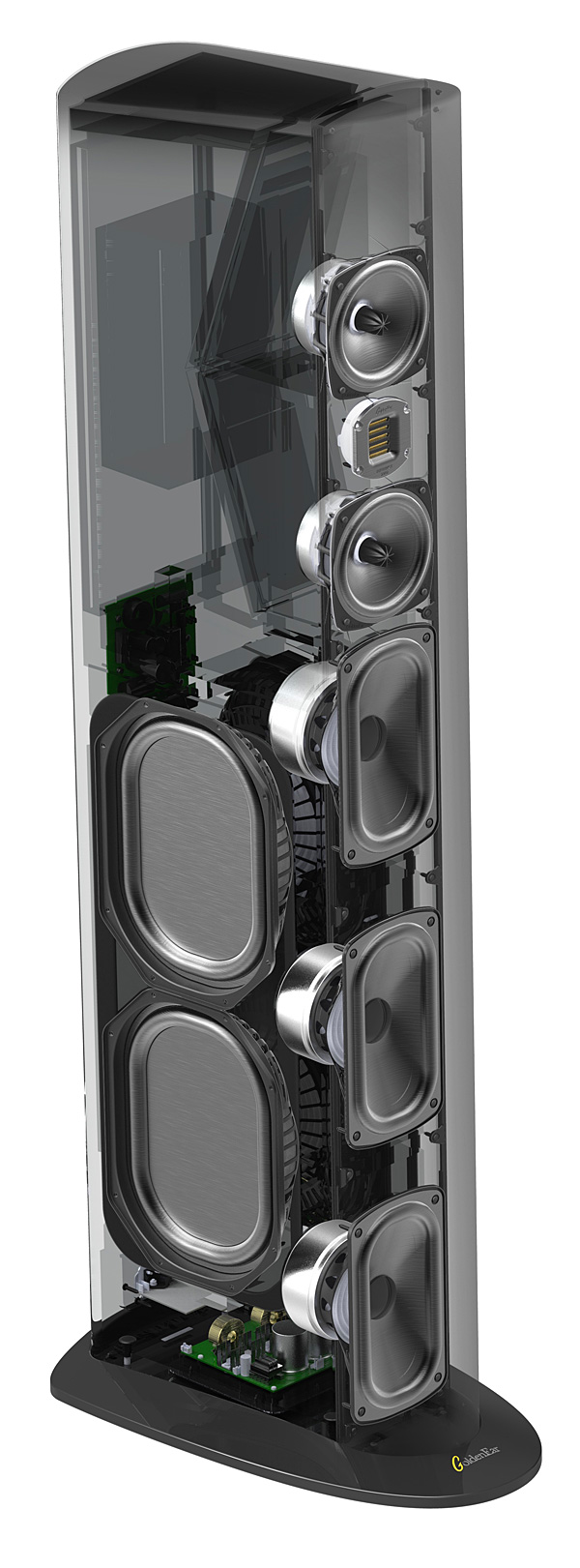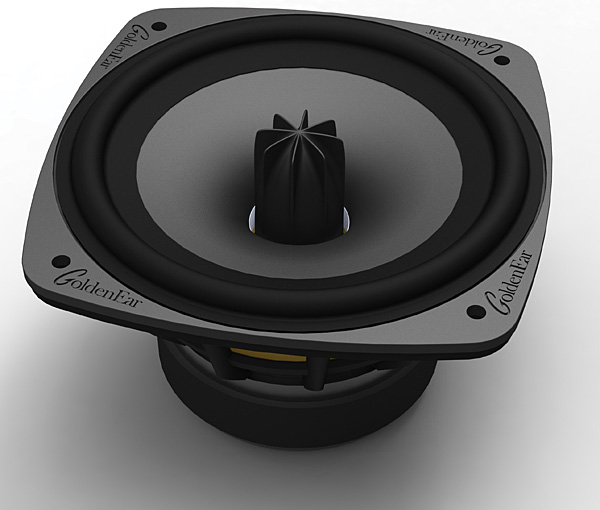I have heard that the Golden Ears have a very narrow sweet spot. If true, this would eliminate them from my consideration as I do not listen in a room with an audience of one (me)- especially as part of a home theater system. Can you please address this?
GoldenEar Technology Triton One.R Loudspeaker Review Page 2
Performance
To get a sense of how the speakers sounded in my room during his visit, Gross played a mix of demo tracks he typically uses at audio shows. Thankfully, he left that CD behind. One track, “Nomads,” by jazz bassist Buster Williams, really captured my attention. Listening to it, Buster’s standup bass sounded completely seamless as he wound his way from the highest to the lowest registers of the instrument. Cymbals and piano had a crisp, airy presentation, and a vibraphone floated across the soundstage in a strikingly 3D-like manner during Stefon Harris’ solo. The powerful sense of atmosphere that the One.R speakers conveyed conjured up memories of my time with the Triton Reference, which had a similarly vivid and realistic presentation.

Another thing that captivated me about the Triton Reference when I reviewed it in 2017 was its incredibly transparent rendering of vocals, and the new One.R proved equally adept in that department. Streaming “Stay” from the new Cat Power album “Wanderer” via Tidal, Chan Marshall’s fine-textured voice came through in an effortless manner and stood in solid relief against the piano chords in the background. Pulling out a CD of Push the Sky Away, by Nick Cave & the Bad Seeds, the singer’s deep, upfront voice on “We No Who U R” sounded distinctly fleshed-out, but also well-blended with the song’s female backing vocals.
On a recent road trip, I was impressed by how good some tracks on the new The Beatles (White Album) reissue sounded, even when streamed through my car’s none-too-great stock audio system. I looked forward to returning home and hearing those same tracks. Listening to new mix of “While My Guitar Gently Weeps” via Tidal, the panoramic soundscape that the One.Rs rendered was a revelation. Drums and percussion spread impossibly wide to the right and left, leaving loads of space for the piano and George Harrison’s smooth vocals. Eric Clapton’s “weeping guitar,” meanwhile, towered hugely over everything during his solo. The One.R’s vivid presentation of this remixed track left nothing to the imagination—all detail contained in the now 50-year-old recording was brought forth and laid bare.
A full-range tower speaker should be expected to reproduce orchestral works with a convincing sense of dynamics and scale. To confirm that with the One.R, I turned to Mahler’s Symphony No.1 as played by the Florida Philharmonic Orchestra conducted by James Judd (Harmonia Mundi CD). Listening to the tentative intro of the symphony’s first section, the delicate, extended scrape of bows across violins cut cleanly through space and the fluttering piano and woodwinds were conveyed with equal clarity. As this section neared its climax, the One.R’s folded ribbon tweeter presented the piercing blasts of brass in a detailed, airy manner, while the slam of the kettle drums and cymbals were appropriately thunderous.

With the Triton One.Rs dispatched to my home theater setup, I didn’t once feel a need for additional subwoofers, even when watching action flicks with ass-kicking DTS-HD Master Audio soundtracks. The footfalls of the monstrous Kaiju in Guillermo del Toro’s Pacific Rim, for example, had a window- and bone-rattling punch, along with ample low-end extension. Playing the new Ultra HD Blu-ray of 2001: A Space Odyssey, the eerie massed voices in Requiem, the Ligeti choral work that director Stanley Kubrick uses in the scene where the black monolith first appears on earth, seemed to blast through the room like a windstorm. And when the action cut to a scene where a pre-human creature is bestowed with the insight that bones can be used as tools to smash things, the bombastic swells of brass and kettle drums in Strauss’ Also sprach Zarathustra displayed even more intense gut-punching slam than what I had heard during the Mahler symphony.
Conclusion
My time spent reviewing GoldenEar Technology’s flagship Triton Reference speaker in 2017 turned out to be something of an event—I had never before had an opportunity to listen with a serious full-range tower speaker in my listening room, and I absolutely liked what I was hearing. To me, the Reference’s $8,498/pair price seemed very fair for the quality and scale of sound that those speakers delivered.
Listening to the company’s Triton One.R in the same space, I have to say I’m even more floored than I was by the Reference. That’s because the new model delivers equally full-range sound, along with many of the same qualities that made that earlier speaker so impressive: clear, fleshed-out mids; airy, transparent highs; and linear, low-reaching bass courtesy of a built-in subwoofer that lends itself equally well to music or movie soundtrack reproduction. The Triton One.R’s more compact form-factor proved to be another plus in my room since it didn’t loom as large and intimidatingly. At just under $6,000/pair, I expect that this formidable new speaker will cut into the company’s sales of the Reference, but I’m sure they knew that going in. If I could pull a Spinal Tap and push the Triton One.R’s Value rating past our usual maximum, I’d do it in a heartbeat.
- Log in or register to post comments


I had a pair of original Triton 2, and now a set of Triton 1. Sitting about 9 feet apart, 10 feet from my "listening couch" - which seats 3 - the sweet spot is MUCH bigger than the couch. In fact, that's what sold me on the Triton 2 that I bought. When I listened to them in the showroom, I could walk around all over the room, standing, sitting with almost no difference in sound quality. Imaging was kind of holographic - instruments and singers were in the same places, but the perspective on their location changed as you went from one side of the room to the other.
The place where I got the Triton 2 delivered and set up, and when I said "Hey wait, that's a STUPID amount of toe in" they took the time to show me... The holographic imaging was spectacular with a lot of toe in. It went almost completely away, and flattened out, as you removed the toe in. On GoldenEar's web site, they're VERY clear about lots of toe in. When I first heard the Triton 1, Sandy was there, and I think everyone asked him why they were toed in so much. Sometimes my kids will be sweet and help clean, and I can tell you the second I turn on music if they screwed up the toe in.
What I love about these speakers... when we have people over, all through dinner, people are jumping up to scurry from dining room to family room for some song or another. Once at dinner, all conversation suddenly stopped for quite awhile, followed by someone whispering "damn that's really spooky... Muddy Waters is in your family room." And then she snuck over to check.
Our home theater is Triton 1, with a SuperSat 60C center, and Aon 3 for backs. Great for movies. We've laughed as our dogs tracked a movie dog around the room. Spectacular for concert videos.

Awesome and helpful response, Ed. I will keep the Golden Ears on my short list. Sounds like they are as musically involving as their imaging prowess.

Also, I understand that say, the Reference, is not the right solution for every size listening room. Can you give recommended Golden Ear models for various listening room sizes? Mine, for example, is 400 sq ft. And does the height of the room influence this? Thanks

I have a similar sized room with 10 foot ceilings. I have the Triton 3+'s and they fill the room with rich robust sound. I am extremely happy with them and my guests are always impressed. Considering my own budget, the 3+'s are perfect for me. It should be noted, that I do run an SVS SB16 Ultra to fill out the bottom end for music (and of course I crank it up for movies). Per your taste in bass, the 3+'s or larger Tritons may not require this.

Thanks, Fluff. Good and helpful info!

We had Triton 2 in a really large space where we used to live, and the bass level was set to 12 o'clock. When we upgraded to Triton 1, the setting was well below that. In our new place, which has a much lower ceiling, it's turned down even lower. Square feet isn't the right way to think, it's cubic feet.

I love Powered towers for an A/V systems, not so much for Audio only.
I auditioned the original Triton one and the Reference, both excellent speakers for an A/V systems.
My own A/V system consists of DefTech ST-L mains, STS rear towers, side monitors and Myths center channel as well as an additional original Super Cube.
I much enjoy my system for movies, concerts on bluray, and even just for music only.
However, at $6,000 you start getting into direct competition with Speakers designed and engineered with Audiophiles in mind.
Focal, Revel, B&W, PSB, KEF, now Paradigm and others manufacture some somewhat affordable (read starts at $5,000) Main Tower speakers that together with a very good sub will outshine Golden Ear and Def Tech powered towers for music only enjoyment.
Don't get me wrong for those of us who are true A/V enthusiasts, top of the line Powered towers from Golden Ear and Def Tech are a dream come true.
However it is my experience that the far majority of Video enthusiast cap their spending on their speaker system at $5,000 (for most that is 7.1 or 9.2).
Meanwhile Audio enthusiast start at $5,000 for their main speakers (as they usually prefer stereo).
Consequently Golden Ear Triton One R finds itself in the reverse Goldilocks position.
Too expensive for video guys, too shabby for snobby audio guys.
Results, not many sales.
Lucky for me that is exactly how I put together my system.
Floor demo models that were hardly auditioned, and put out to pasture at a dramatic discount to make room for more popular models.

I want to keep my setup simple and listen to 80% movies, and 20% music--although I'd like to listen to music more, and i have the choice between buying the one.r and keeping my sb16-ultra, or buying the reference and selling the sb16-ultra. I like the idea of just two speakers--for a simple clean looking configuration along with a unified sound, but I want the same mids/highs of the reference. My room is only 2000 square feet, and I am running any GE with anthem STR. any suggestions? thanks!





























































